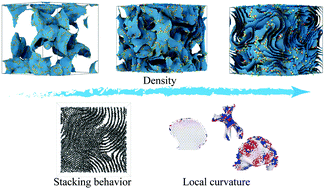Formation and topological structure of three-dimensional disordered graphene networks†
Abstract
Disordered graphene networks (DGNs) can be regarded as the three-dimensional (3D) assembly of graphene-like fragments at the nanoscale, in which some intrinsic topological features are usually hidden in these formless fragments without clear understanding. Although some high-resolution structural patterns have been observed in pyrolytic carbons and flash graphene experimentally, it is still hard to characterize the topology and texture of DGNs considering continuous 3D connectivity. Toward this end, starting from the annealing process, we herein performed molecular dynamics simulations to investigate the formation and topological structure of DGNs. Three typical stages are found during the formation of DGNs, that is, the formation of polyaromatic fragments, formation of a disordered framework, and further graphitization. The topology of the obtained DGNs was then investigated, including topological defects, stacking behavior, and global curvature. Several typical in-plane and out-of-plane topological defects are found to connect the 3D network of graphene-like layers. The computed X-ray diffraction and angular defects demonstrate that a high-density DGN tends to form a randomly stacked structure with more connections, while a low-density DGN exhibits more bowl-shaped layers and a less distorted curvature. At low annealing temperatures, the local curvature of DGNs is highly distorted, and the structure seems to lack graphitization compared to high-temperature ones.

- This article is part of the themed collection: 2021 PCCP HOT Articles


 Please wait while we load your content...
Please wait while we load your content...